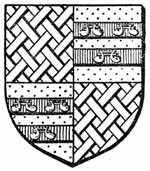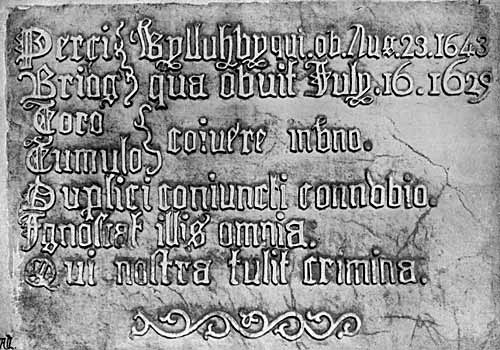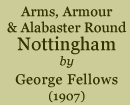< Willoughby | Contents | Wysall >
St. Leonard's, Wollaton.
 |
THE QUARTERED ARMS OF WILLOUGHBY—First and fourth, Or, fretty azure; second and third, Or, on two bars gules, three water-bougets argent. |
THIS Church also contains numerous monuments to members of the Willoughby family. There is a large stone tomb under an arch, with a cadaver beneath, to Sir Henry Willoughby, Knight Banneret, and his four wives (H. VIII.), and brasses to Richard Willoughby and his wife (1471), on a Purbeck marble slab under a handsomely carved canopy of stone with shields of arms, very similar in design to the one in Strelley Church, together with numerous mural tablets extending down to recent times: these, however, not being of alabaster, do not come within the scope of this book.
Built into the south wall of the Chancel is a square of alabaster carved with attractive lettering, and with so quaintly-worded an inscription that it would seem a pity to omit all mention of it in a book devoted to the work produced by local alabaster "kervers." The inscription has been paraphrased—
"One tomb in death, as erst in life one bed, Holds man and wife in double wedlock bound; May He in whom our load of sin was laid, Pardon whate'er of sin in them was found."
 |
Inscription to Percival and Bridget Willoughby. |
Sir Francis Willoughby, who built the Hall, some three-quarters of a mile away, in 1580—88, had a large family of daughters but no son. He was naturally in despair at the prospect of the name, estates, and the magnificent house he had built passing away to others; he even contracted a second marriage in his old age, but still no heir was born, so with a view to retaining the family name with the estate, a match was arranged between Bridget, his eldest daughter, and her distant kinsman, Percival Willoughby of the de Eresby branch. This tablet and inscription was erected to the memory of this couple, and constitutes the only monument to them. Percival Willoughby was knighted by King James I. His grandson was the great philosopher, whose son Francis was made a Baronet, but dying unmarried his brother Thomas succeeded to the Baronetcy, and was subsequently raised to the Peerage as Baron Middleton of Middleton (1711), taking his title from his Warwickshire property. The present Lord Middleton is the ninth Baron.
![]()
< Willoughby | Contents | Wysall >
